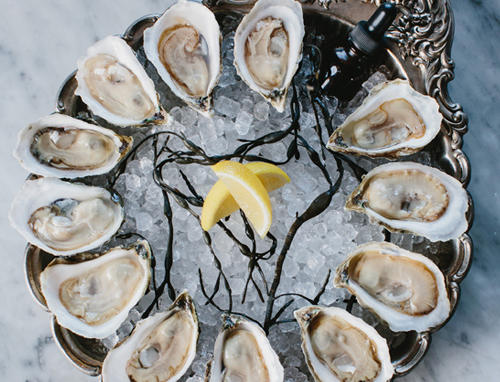
Section Branding
Header Content
A Fork in the Road Podcast: Kimball House
Primary Content
Fresh-from-the-garden vegetables, a wide variety of oysters, and expertly crafted cocktails all in one of the 10 best-designed bars in America. In this episode, you'll learn how one restauranteur's passion for the aquaculture of the South has made Decatur, Georgia a prime destination for oyster lovers everywhere. Plus, which is better: oysters from a farm or oysters harvested in the wild?

Bryan Rackley: Georgia's coast is made up almost entirely of marshland. So all that grass and all that vegetation produces qualities that affect the flavor of of those oysters.
David Zelski: When it comes to food you have to work to eat, few things have a pay-off as delicious and satisfying as an oyster. In Decatur, Georgia, the Kimball House offers a wide variety of farm fresh oysters from all over the country. But their approach to the industry is uniquely Southern. That’s where the Fork in the Road is taking us today.
Theme Song: I came from the mud, there's dirt on my hands. Strong like a tree, there's roots where I stand.
David Zelski: I'm David Zelski, and this is the Fork in the Road podcast presented by Georgia Grown and the fine folks at Georgia Public Broadcasting. Each episode, we feature stories from Georgia's farmers, fishermen, merchants, artisans, chefs, and others who help provide Georgia grown products to folks in the Peach State and beyond. Today we are six miles east of downtown Atlanta in Decatur, Georgia. We’re here to talk to Bryan Rackley. He’s one of the founders of Kimball House, an award-winning oyster restaurant right off the Decatur square.
Kimball House provides a thoughtfully curated selection of the best oysters the country has to offer, along with a stellar wine list and expertly crafted cocktails that have been recognized by the James Beard Award Foundation. The cozy environment makes it the perfect date night destination to top off a cool evening stroll in bustling downtown Decatur. And as Bryan explains to me, the mission of Kimball House is more than just great food.
Bryan Rackley: We are focused on, number one, making people happy. Number two, sustainability, sourcing and making sure that what we're doing is the right thing for the people that we're leaving this restaurant to when we are gone.
David Zelski: Kimball House opened in 2013. But the space was originally a train depot built in 1891. Brian says the history of the building itself gives it part of its magical quality.
Bryan Rackley: The building is special, honestly, because it's a building from 1891. And frankly, at the base level, you just don't really get a lot of that In Atlanta. There's not a lot of old structures that you could turn into a restaurant at this point. So the fact that we were able to take this building and implement our vision and have it be something that was really just greater than all of us as people, it's really just kind of taken on this like this, this entity. And I don't think that we could have done that with a new space. There's something kind of magical about going back in time when you walk into this space and sit down at the bar and eat oysters.
David Zelski: Speaking of those oysters -- if you’re a fan, Kimball House is an absolute bucket list spot. They boast an unreal variety of oysters from oyster farms around the country. They even started harvesting and offering their own in 2022 when Bryan and his partners created Shiny Dimes Oysters, a burgeoning oyster farm located in Spring Creek, Florida.
At Kimball House, even though their oysters come from all over, for Bryan, his heart lies in the aquaculture of the South.
Bryan Rackley: We buy oysters that are farmed from all four corners of the United States. We have a very rich focus here in the South as of a few years ago. I work with a nonprofit that's regional called Oyster South. We do a lot of fundraising, a lot of awareness and a lot of promotion for aquaculture in the Southeast. And we've seen that work very well all the way from Alabama down through Florida. And now we're kind of ticking up around the East Coast and there's a very good agricultural programs happening in North and South Carolina. And hopefully we are going to see some more stuff here in the state of Georgia in the next couple of years.
David Zelski: If you’re an oyster aficionado like producer Jeremy, you know all about the nuances and subtleties in the flavor profile of different varieties.
Producer Jeremy: Mmm. Chesapeake Bay. Very nice.
David Zelski: That flavor differs based on where the oysters were harvested, but as Bryan tells me, that’s not all.
Bryan Rackley: I mean, there's just so much variation. I mean, you can have variation from one oyster all year long, from month to month. You can get different things away in terms of like what you're perceiving, in terms of vegetation and sea floor and all the things around it that are affecting the flavor of that oyster. So it really depends on species and harvest location. Georgia's coast is made up almost entirely of marshland. So all that grass and all that vegetation produces qualities that affect the flavor of those of those oysters. I often notice that there's this like a sort of spring onion or breakfast radish or elements like that that make that oyster really bright. And I think that that's what you're looking for in any oyster is salt in every single oyster, regardless of whether it's a high salinity harvest location or a low salinity harvest location. But, you know, it's really neat when you have something that can set your oysters apart from the region next to yours. And and that's why, you know, those profiles that I get out of Georgia oysters are very much different from the next closest region which is South Carolina.
David Zelski: The environment in which the oysters are grown also affects their look.
Bryan Rackley: The sea floor is going to have a profound effect on the color of the oyster, the type of mud or the type of substrate that you're dealing with will change oysters, from one harvest area to the other in terms of their color. Growing in super muddy areas, which is what most of those marshes are. I find it interesting that they would take on this color. I would expect Georgia Oysters to have kind of a darker color. But right now, these are coming in with more of a reddish color. But that can change throughout the year depending on what's in the water, what's growing in the water from like a vegetation point of view.
David Zelski: These farm-grown Georgia oysters are as beautiful to look at as they are to eat. So what are they served with? At Kimball House, they keep the presentation sparse, and try to let the flavor of the oysters do the talking.
Bryan Rackley: If crackers and cocktail sauce are your thing, then you have every right to do so. And you are not wrong for doing so. But for our oysters, we offer simply lemon and mignonette. Just something to add a little nuance to the salinity in the oyster. But what we really try to discourage is for masking the flavor of the oyster. So this is how we dress ours. We've got a mignonette that is apple cider vinegar and champagne vinegar that's infused with shallots and peppers. And then we also offer lemons. We just try to encourage people to eat oysters with as little additions as possible so they can experience what that water, where they were harvested, what that water tastes like. So when you eat this oyster, you are literally consuming the marshes of Georgia
David Zelski: When it comes to farming oysters compared to harvesting them from the wild, Bryan says farming allows for a product consistency which his customers really appreciate.
Bryan Rackley: One of the things that farming gives you some control over is consistency. So, I mean, if you look at these, they might have some variation from shell to shell, but they're all basically the exact same size. And the fact that you are able to split your bags up and control the density of the the sheer number of oysters growing in each cage or bag gives you an opportunity to produce something that's that's fairly consistent. And, you know, that's that's what people will look for when they when they spend money in restaurants or bars or even fast food. People want consistency. They want stuff that looks the same and tastes the same time and time again. The fact that you can produce stuff that looks like this and it starts to starts to appear as if it came off of a printer instead of out of out of nature gives you a better opportunity to win guests over year round.
David Zelski: With impossibly delicious food and a layout recognized by Dwell Magazine as one of the 10 best-designed bars in America, Kimball House has earned its place as one of the most popular eateries in the metro Atlanta area. Don’t believe me? Pause this podcast and try to get a reservation, for two, at 7 tonight. Go ahead. I’ll wait.
MUSIC: Hold music
David Zelski: Okay, better luck next time. But keep trying, and get in when you can. Trust me, it’s well worth it. The oysters are of course the talk of the town, but Kimball House’s dedication to quality and freshness reaches all parameters of their food. They even grow some of the produce they use right there on site. Doesn’t get fresher than that.
Bryan Rackley: When we opened the space, we knew we had a little bit of property around us. We know that working with chefs, having their hands on food, even if it's like on a very small level, hands on, I mean, having the hands of food that they're actually a part of the lifecycle of is a big deal for them. So to have figs and raspberries and blackberries and you know, and that we just turned over our garden over here and it's got soy and bok choy and some, some turnips in there and the ability to go out and harvest stuff on a daily or weekly basis. I think it's really just like a meditative process for the people that work here to step outside of the restaurant, get fresh air, bring in some produce, is something that, you know, keeps people centered when they're at work.
David Zelski: Kimball House shows a love for their industry that really makes the state of Georgia proud. And as long as adventurous upstart farms keep blasting ahead on the oyster frontier, Kimball House will serve the results to hungry customers.
Bryan Rackley: Hopefully within the next two or three years, we're able to bring on a lot more farmers. You know, we will will sponsor them as soon as they're in a position to sell us stuff. So, we just look forward to a future where there's more people experiencing the opportunity to grow oysters and to bring them to our restaurant. Our guests love them and we can't wait to share that with them.
David Zelski: For more stories like this one, you can watch A Fork in the Road on GPB TV or any time on the GPB.org website. GPB.org/Podcasts is where you can listen to and subscribe to this podcast or download it on your favorite podcast platform.
I'm David Zelski. Thanks for listening to A Fork in the Road.
The A Fork in the Road TV show airs Saturdays at noon and Sundays at 6:30 a.m. on GPB-TV. Check your local listings for other replays throughout the week and watch all episodes anytime at GPB.org/ForkintheRoad. Please download and subscribe to the Fork in the Road podcast at GPB.org/ForkintheRoadpodcast or on your favorite podcast platform as well.







